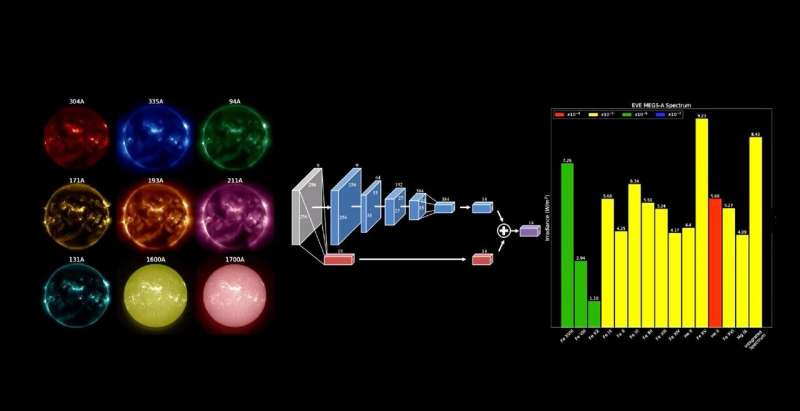Credit: EVE MEGS-A Spectrum
A NASA Frontier Development Lab (FDL) team has shown that by using deep learning, it is possible to virtually monitor the Sun's extreme ultraviolet (EUV) irradiance, which is a key driver of space weather. The Sun is vital for survival, but solar flares, which typically occur a few times a year, have the potential to cause severe disruptions in space and on Earth. These disruptions can impact spacecraft, satellites and even systems here on Earth, including GPS navigation, radio communications and the power grid. Deep learning can help get more value out of our current ability to monitor the Sun by providing virtual instruments to supplement physical devices. This research will be published in Science Advances on October 2, 2019 ("A deep learning virtual instrument for monitoring solar extreme ultraviolet spectral irradiance").
"Our research shows how a deep neural network can be trained to mimic an instrument on the Solar Dynamics Observatory (SDO)," said FDL team member and co-author Alexander Szenicer (Oxford University). "By inferring what ultraviolet radiation levels that sensor would have detected based on what the other instruments on SDO are observing at any given time, we demonstrate it is possible to increase scientific productivity of NASA missions and to increase our capability to monitor solar sources of space weather."
FDL is a partnership between NASA Ames Research Center, the SETI Institute and private sector and space agency partners including Google Cloud, Intel AI, IBM, Kx Lockheed Martin, Luxembourg Space Agency, NVIDIA, Canadian Space Agency, HPE and Element AI. During an 8-week summer research accelerator, interdisciplinary teams comprised of early-career researchers in AI and natural science domains work together to apply AI and machine learning to address important challenge questions. The challenge question behind this research was to develop an AI model using SDO images to predict solar spectral irradiance.
This video outlines the project and its motivations. Credit: NASA SDO
Traditionally, methods for monitoring solar EUV spectral irradiance include physics-inspired models that attempt to predict EUV emission. Such methods use either magnetic field distributions on the Sun's surface or physics-based inversions of the plasma distribution in the Sun's corona.
(Top) Input AIA images (Bottom two rows) Our network can be interpreted as producing a set of images measuring at each pixel, the irradiance at a particular wavelength. Our model is often looking at sensible locations for making its decisions, for instance during flares. Credit: NASA SDO/AIA
These new results show it is possible to use imaging observations of the Sun to create a proxy measurement of EUV spectral irradiance. Feeding coronal images from NASA's SDO to a deep neural network allows us to generate proxy EUV measurements with an accuracy that surpasses physics-based models.
After being trained on four years of data, our network (center) can ingest AiA images (left) and output predictions for EVE MEGS-A spectrum (right), in this video for the year 2015. Credit: Alexandre Szenicer
Additionally, the team developed benchmarks and protocols for comparing predictions between EUV models. These will be useful for future studies. Thus far, research has barely scratched the surface on what's feasible by combining deep learning with large-scale scientific space data. Data science and machine learning will play increasingly important roles in our endeavor to understand the origins of space weather and how to live with the Sun.
More information: Alexandre Szenicer et al. A deep learning virtual instrument for monitoring extreme UV solar spectral irradiance, Science Advances (2019). DOI: 10.1126/sciadv.aaw6548
Journal information: Science Advances
Provided by SETI Institute
























